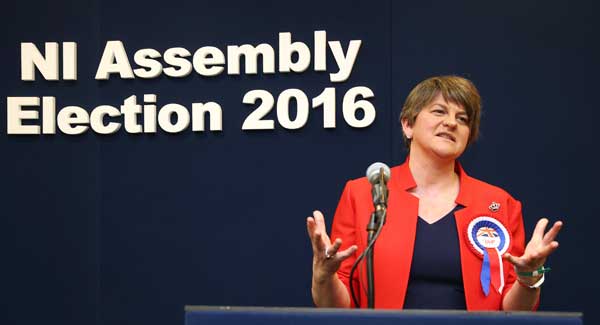Democratic Unionist leader Arlene Foster has hailed her party’s “tremendous” performance in the Northern Ireland Assembly election after an unexpected repeat of its best ever Stormont haul.
The 38 seats won by the party is the same number it secured in 2011 in an election many, including party strategists, viewed as a one-off historic high water mark.
While much of the campaign focused on whether Sinn Féin could eclipse the DUP as the North’s largest party – a possibility Mrs Foster herself repeatedly warned of – in the event the gap between the two main Stormont parties actually grew, albeit slightly.
Sinn Féin’s 28 seats was one short of its tally in 2011. It was also shy of the significant 30 seat threshold that would have handed the republican party extra power to veto Assembly legislation.

In an election that saw most of the main parties consolidate their seat strength, there were also some notable victories for the smaller parties, with the People Before Profit Alliance (PBPA) and Green Party both winning two seats each.
The DUP’s showing is undoubtedly a strong validation of Mrs Foster’s leadership, coming six months after she replaced the retiring Peter Robinson.
“It has been a tremendous election and I feel very energised by the fact the people have put their trust in us,” said Mrs Foster, who topped the poll in her own Fermanagh and South Tyrone constituency.
“It’s a strong endorsement of the direction of travel. We set out a five-point plan for a safer, stronger Northern Ireland, that is what have discussed right across the country as I criss-crossed across the country.
“We got a very warm reception for it and that has shown in the ballot boxes.
“The people have spoken, we have now received mandates and we must now put those mandates into action.”
Mrs Foster will now return as Stormont First Minister. The former Ulster Unionist, who defected to the DUP in 2004, said she “wanted to get things done” in the term.
“I am very determined, and I am incredibly proud to be the leader of this great wee country that we call Northern Ireland and I am looking forward to leading it over the next mandate,” she said.

Over the coming days, the emphasis will shift to negotiations between the main parties on the shape of the new coalition administration, its agreed programme for government and which parties will take on which ministerial portfolios.
Two things are different in the wake of this election – firstly, the talks on the programme for government are taking place before the executive is formed and, secondly, parties can now avail of the recently-established option of forming an official opposition rather than entering the executive.
Of the 108 candidates elected to Stormont, the DUP has 38, Sinn Féin 28, the Ulster Unionists 16, the SDLP 12, Alliance eight, PBPA two, Greens two, with the Traditional Unionist Voice (TUV) and independent Claire Sugden winning one each.
The SDLP and Ulster Unionists both had disappointing elections.
The SDLP, the once dominate power within nationalism, has dropped two seats on its 2011 tally. Though the UUP repeated the 16 seat haul of 2011, it did not make the in-roads leader Mike Nesbitt had confidently predicted. Reflecting on the outcome, Mr Nesbitt said: “Not great but not bad”.
For the Alliance Party, which also won eight seats in 2011, it was a case of “as you were”.


